
* Corresponding author.
E-mail addresses:shokrieh@iust.ac.ir (M. M. Shokrieh)
© 2013 Growing Science Ltd. All rights reserved.
doi: 10.5267/j.esm.2013.08.001
Engineering Solid Mechanics 1 (2013) 69-76
Contents lists available at GrowingScience
Engineering Solid Mechanics
homepage: www.GrowingScience.com/esm
Designing and manufacturing of a drop weight impact test machine
F. Taheri-Behrooz, M.M. Shokrieh* and H.R. Abdolvand
Composites Research Laboratory, School of Mechanical Engineering, Iran University of Science and Technology, Tehran, 16846-13114, Iran
A R T I C L E I N F O A B S T R A C T
Article history:
Received January 20, 2013
Received in Revised form
July, 2, 2013
Accepted 6 August 2013
Available online
7 August 2013
A state of the art instrumented Drop Weight Impact Tester Machine was developed in Iran
University of Science and Technology which measures the energy absorption of composite
materials under impact load. The output of the machine is used to draw load- time graph and
calculate the amount of energy absorbed by the specimens. The machine was equipped with
various sensor systems to measure the velocity of the impactor just before it contacts the
specimen and the amount of contact force, and with a data acquisition system to record the
force and time history. Capability of testing according to many different types of standards and
capability of studying behaviour of the specimen after impact are two important characteristics
of this machine. This designed system, after manufacturing and calibration, was installed and
successfully utilized.
}}
© 2013 Growin
g
Science Ltd. All ri
g
hts reserved.
Keywords:
Drop Weight Test
Manufacturing
Toughness
Composites
Impact
1. Introduction
Because of high specific strength and modulus, low specific density and corrosion resistance, fibre
reinforced plastics are used in vast majority of fields such as aerospace, transportation and building
structures. In order to optimize designing with these materials it is necessary to perform standard tests
and find out their mechanical properties. Toughness is an important property of composite materials
and shows energy absorption capacity of the specimen. This energy is measured by impact testing.
Izode and Charpy are two popular methods of impact testing but with many restrictions such as:
necessity of using notch in the specimen and limitation on the magnitude of applied load. There is
another method which use falling weight to measure energy absorption capacity of materials, called
Drop Weight Impact Testing (DWIT) with many advantages as mentioned below:
Capability of testing based on different types of standards and shapes.

70
Results of tests are in form of load-time and absorbed energy- time format, so the history of
failure can be studied more precisely.
Recording 100 data in 0.001 s makes the result more accurate and precise.
Capability of testing of specimens under any slope.
Capability of investigating of behaviour of specimens after impact test.
Ghasemi-Nejhad and Parvizi-Majidi (1990) and Madjidi et al. (1996) utilized a DWIT machine which
had ability to test specimen with any angle in mounting, also they studied compressive behaviour of
the specimen after impact test.
Under impact loads, composite materials show different responses in comparison with metals. Metals
under impact loads show a short elastic response that followed by a long plastic deformation. While,
in composites, elastic response is followed by different modes of failure such as delamination, matrix
cracking and fibre breakage. In fact in metals, the impact energy is absorbed by plastic deformation.
However, composites absorb energy by different failure modes. Composites response under impact
force was studied by many researchers based on the developed drop weight impact test machines. For
instance DWIT machines have been developed by (Zoller (1983); Winkel and Adams (1985); So and
Francis (1991); Ambur et al. (1995); Toropov and Grosso (1998); Barr and Baghli (1998) and
Gunawan et al. (2011)). The research results show that the duration of Impact is about millisecond.
This is an important factor for choosing the appropriate load cell and data acquisition instrument.
The main goal of this research is to design and manufacture of a DWIT machine which serves the
abovementioned mentioned advantages over the traditional Izode and Charpy test methods.
2. Energy Absorption Calculations
The most important measurable factor by a DWIT machine is the energy absorption, although, the
load-time graph has useful information. The traditional way of measuring energy absorption was
calculating kinetic energy before and after impact. However, a DWIT measures the load versus time
more accurately and precisely and illustrates energy absorption history. Different failure modes
caused by impact can be studied from the load-time history graph obtained from the machine.
Change in kinetic energy is calculated by equations 1 and 2
dyFvmvm 2
2
2
12
1
2
1, (1)
dyF Absorbed Energy, (2)
where m is the mass of impactor, F is the force, y is the displacement, 1
and 2
are the velocity of
impactor before and after impact, respectively.
Eq. 1 is used for calibration and shows whole absorbed energy. While Eq. 2 shows absorbed energy
at every moment. An installed load cell on DWIT is used to measure F(t). Displacement as a function
of time y(t) is obtained by double integration of the acceleration. Eqs. 3, 4, and 5 show energy
absorption calculations.
m
tF
ta )(
)( , (3)
dtdttaty ))(()( 1
, (4)
dyFyF
tF
ty )(
)(
)( . (5)

F.Taheri-Behrooz et al. / Engineering Solid Mechanics 1 (2013)
71
A numerical method is used to calculate Eq. 4, and 1
is measured experimentally by a photocell. The
absorbed energy at any moment is obtained by Eq. 5 if the displacement and force as functions of
time are known.
3. Detail design of low velocity impact test machine
A general view of the design procedure of the machine is presented in this article. More information
is available in the final report of DWIT provide by Shokrieh et al. (2002). DWIT consists of many
components such as: chases, Impacting mechanism, elevation system, fixture systems, power and
protection system, pneumatic system (Brake and release system) and a data acquisition system.
Figure 1 shows the DWIT machine designed and manufactured in this research.
3.1. Plate of the machine
The calculations of the base plate of the machine are carried out by simulating it with a mass-spring
system. After calculating spring constant of plate, its deflection is calculated and finally the stress is
obtained. Eqs. 6 and 7 are the energy equations and simulate plate with spring–mass system to find
spring constant.
By assuming m=20 kg, g=10 m/s2, h=1.2 m:
mghKye 2
2
1 (6)
2
480
y
K (7)
The plate rigidity is as follow:
Nm
Et
D47.11738693
)1(12 2
3
(8)
where e, E, k, y, h, D, t,
, are energy, elasticity modulus, spring constant, deflection, release height,
plate rigidity, thickness and Poisson’s ratio, respectively.
From Hooke's law and considering the distributed force (q) per unit area we have:
kyqabkyF (9)
where a=100 mm and b=200 mm.
Fig. 1. DWIT machine

72
For a fixed rectangular plate, bending moment, deflection and stresses are as Eq. 10. For more
information about driving of these equations interested readers are referred to Young (1954) and
Timoshenko and Woinowsky-Kreiger (1959).
4
22
1
,,
xy
qb
yMqbMqb
D
(10)
where
, and 1
are constants and M is the moment.
For concentrated force acting on fixed plate we have:
12
22
66
,,,,
yx
xyxy
MM
M
FM F
bt at
(11)
mmm
m
m
m
m
m
mm
mb
a
D
Fb
y
coshsinh
tanh
1
4
cosh
tanh
1
2
2
,..3,1
2
2
,...3,1
32
2
3
2
max , (12)
where F is concentrated force and a
bm
m2
.
After simplification of Eq. 12, maximum deflection, max
y, is simplified as follows:
D
Fb
y3
2
max 2
436.0
(13)
Table 1 shows the results of equation 10, 11, 13 and Ansys software
Table 1. Results of equation 10, 11, 13 and Ansys software
Method Loading
Conditions ymax (mm)
(MPa) Mx (Nm) My (Nm)
Timoshenko and
Woinowsky-Kreiger (1959)
Distributed 0.31 - 28577 127663
Timoshenko and
Woinowsky-Kreiger (1959)
Concentrated 0.8 154 19544 11920
Numerical analysis
performed by ANSYS
Concentrated 0.55 164 - -
3.2. Jack choosing
Two pneumatic jacks have been selected for the release and shock damping systems. One jack is used
for releasing impactor at any permissible height with outer diameter of 10 mm while the other
pneumatic jack is used for protecting specimen from Second impact when the first impact was
applied with the outer diameter of 40 mm. Operating pressure of jacks is 10 bar. Figures 2-a and 2-b
show the selected pneumatic jack.
(a) (b)
Fig. 2. The selected pneumatic jack: a) release system b) damping system

F.Taheri-Behrooz et al. / Engineering Solid Mechanics 1 (2013)
73
4. Force measurement
During the impact the force transducer sends data to the signal conditioner. After filtering the data, an
A/D card (PCL818H) converts the data to digital mode and sends them by Direct Memory Access
method (DMA) to a computer. DMA is the fastest way for transmitting the data to a computer
without any conflict in a simultaneously reading and writing process. More information about force
signals processing could be found in Huibert and Raphael (1991).
5. Velocity and energy measurement
The absorbed energy and impactor contact speed are measured in this research by two different
methods. In the first method a photocell is used for measuring initial velocity ( 1
). When the bottom
edge of Impactor plate passes through the photocell a signal is sent to the computer. As soon as
receiving this signal, a counter begins to count elapsed time. While impactor passing through
photocell, counter continues to count time until upper edge of impactor passes through the photocell.
Initial velocity is computed by dividing the thickness of impactor (
=7 mm) to the elapsed time.
Also the load is measured by a load cell and finally the energy is obtained.
In the second method by using two equations gh2
and mghe
the velocity and the energy
are calculated. The results for m=20 kg and h=1.2 m are showed in Table (2) for the mentioned
methods.
Table 2. Absorbed energy and impact velocity of DWIT machine
Parameter First method Second method Error %
(m/s) 4.88 4.03 17.41
e (J) 240 223 7.1
The differences between results of two methods are due to friction between the components of the
machine. The flow chart of the automation system is shown in Fig. 3.
Fig. 3. The flow chart of automation system








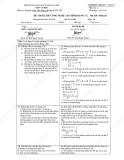
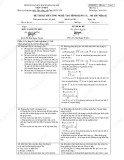
![Đề thi Công nghệ tạo hình dụng cụ năm 2020-2021 - Đại học Bách Khoa Hà Nội (Đề 4) [Kèm đáp án]](https://cdn.tailieu.vn/images/document/thumbnail/2023/20230130/phuong62310/135x160/3451675040869.jpg)





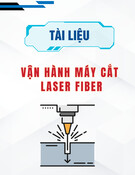



![Bài tập môn Cơ sở thiết kế máy [năm] [mới nhất]](https://cdn.tailieu.vn/images/document/thumbnail/2025/20251008/ltgaming1192005@gmail.com/135x160/26601759980842.jpg)
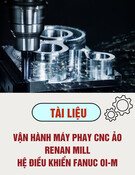
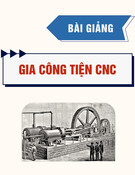
![Tài liệu huấn luyện An toàn lao động ngành Hàn điện, Hàn hơi [chuẩn nhất]](https://cdn.tailieu.vn/images/document/thumbnail/2025/20250925/kimphuong1001/135x160/93631758785751.jpg)


